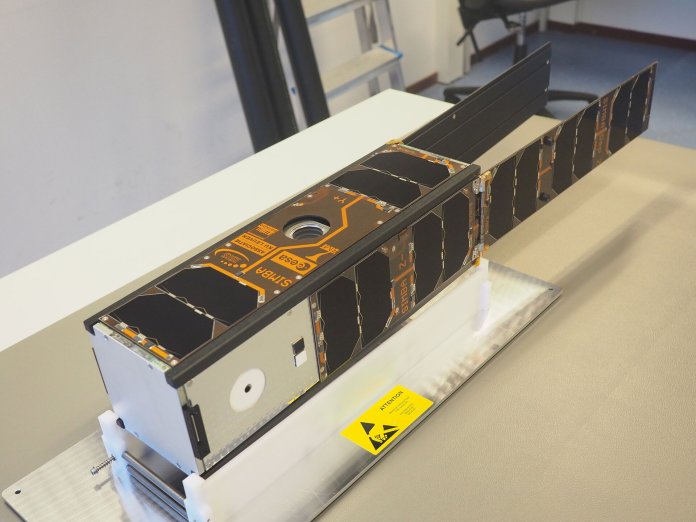Directed by the Royal Meteorological Institute Belgium, Simba is a 3-unit CubeSat mission to measure the Total Solar Irradiance and Earth Radiation Budget climate factors with a miniaturised radiometer tool, due to be launched in 2020 in the inaugural flight of the ESA’s developed’Small Spacecraft Mission System’ dispenser – devoted to CubeSats along with other smaller satellites – to a Vega launcher. Credit: RMI
Because of launching aboard Friday’s Vega rocket, ESA’s Simba CubeSat is a mission with a big ambition: to quantify among the drivers of climate change in a manner. The 30-cm long nanosatellite will turn to sunlight to distance and back again, to calculate the overall energy budget of our planet.
CubeSats are satellites built up from standardised boxes that are 10-cm. Simba, short for’sun-Earth Imbalance’ is a’3-unit’ CubeSat, developed for ESA by a consortium headed by Belgium’s Royal Meteorological Institute (RMI) with the University of Leuven and ISIS-Innovative Solutions in Space from the Netherlands.
“Here really is the kind of scientific tool we’d otherwise put on a full size satellite platform,” clarifies Stijn Nevens, Simba principal investigator in RMI.
“But if we can make this work using a bigger, cheaper CubeSat, then we might be able to build and fly many variations of this tool later on, to cover the whole planet for the equivalent cost of a single standard mission. Because is critical, that is crucial.
“The principal origin of climate change will be that an increasing amount of warmth from the sun is being kept inside the atmospheric system. To measure that directly we need to quantify how much solar energy Earth is receiving – we call it total solar irradiance – then how much of this is being represented by the Earth’s surface and air, or being radiated outside as longer-wavelength heat energy.
Simulated results from the Simba CubeSat mission, which will use a radiometer to measure solar irradiance degrees across Earth’s surface to assist examine meteorology and climate change. Credit: European Space Agency
“Subtracting the second from the first, we wind up with a guess for Earth’s radiation budget – the quantity of energy our planet holds onto instead of reflects or radiates away.
“We have a category of instruments to quantify irradiated energy, also called radiometers, which convert it to electric power for measuring purposes. There are sunward-facing radiometers on satellites such as Proba-2 and SOHO.
“But while their outcomes have high relative accuracy, they require a great deal of additional modelling to take account of factors like diurnal differences and surface versions. Whereas the instruments themselves possess inherent biases, they consequently arrive with a massive margin of error. For sharper climate change modelling we need to do better.”
Caring for our world
The Simba CubeSat in closed country ready to be fitted to its launch pod. Credit: RMI
The notion with Simba would be to achieve absolute accuracy that is greater by employing exactly the tool for the first time to quantify irradiance from the the sun and Earth. The CubeSat will turn from our planet to space – to calibration purposes – then to our parent star.
“We’re using a broadband, wild field of view tool, meaning we’re measuring the complete incoming flux in the whole Earth,” adds Dr. Nevens. “Simba is based on a cavity radiometer, which is basically an inner space on the other side of a tiny hole, entirely painted black. We are currently measuring how that cavity warms up.
“Imagine a home with central heating you would like to keep warm. On a summer evening that you don’t have to do some heating, however on the day of a winter you will eliminate a great deal of warmth and need to actively heat it. So we’ll be measuring how much energy we need to install to keep a predetermined temperature.
“To receive our baseline we’ll start the mission by looking down at Earth for a long time, to find out what temperature it stabilises at. We’ll swivel out to distance, just a couple levels from zero, to find out the level of warmth we need to apply to keep it there. Then we’ll turn to sunlight in turn, measuring the quantity of radiation coming ”
Simba is equipped with a’attitude determination and control program’ or ADCS for short, contributed by the University of Leuven. This comes with an experimental star tracker camera to fix its position against the star constellations in the sky and’ reaction wheels’ whose changing rate of spin cause its approach to be shifted by the nanosatellite in reaction.
We will reach traceability, being able to know precisely where and in what we are looking at any 1 time.”
It will be launched along with dozens of different CubeSats and satellites aboard the flight of ESA’s Vega Small Spacecraft Mission Service that Friday.
– Advertisement –
